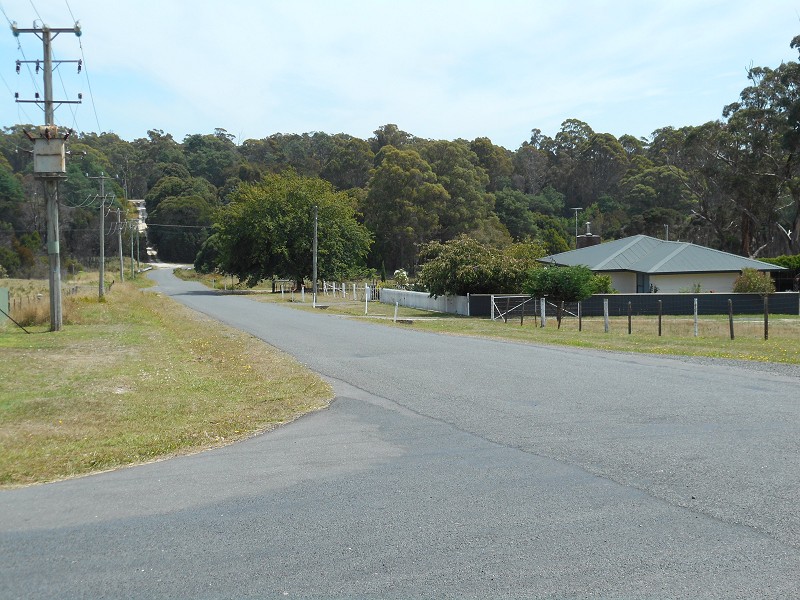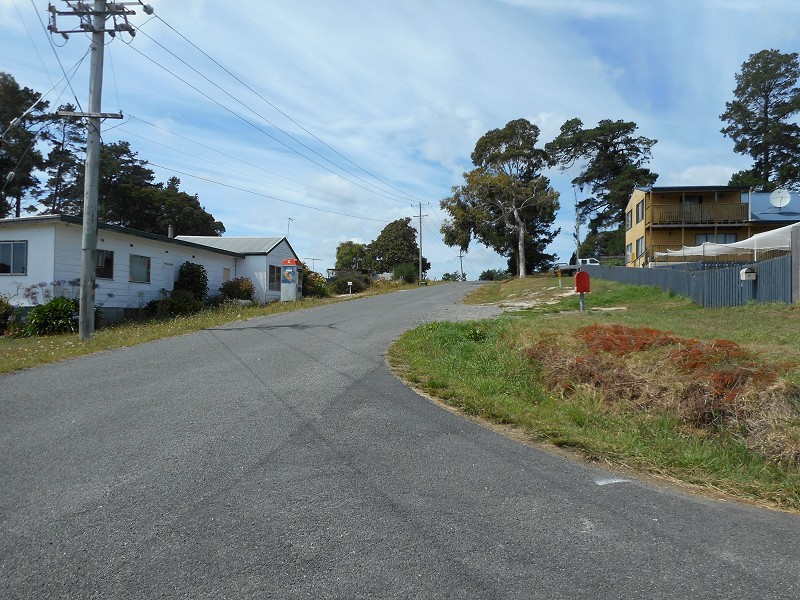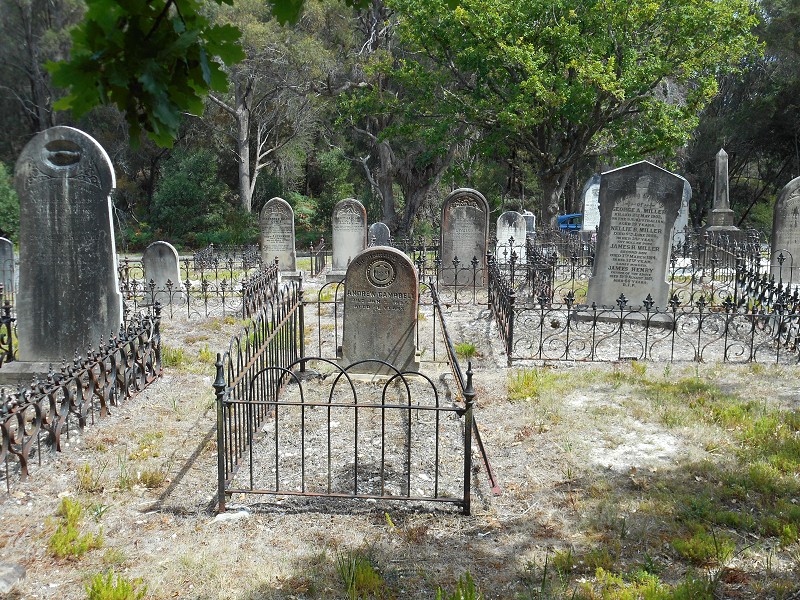(This post is a copy of this post.)
Lefroy, population 2000. Once upon a time.
Gold was found at Nine Mile Springs at various times, maybe even the first place on the island where it was found, but an 1869 discovery was the find of significance. (I think it was alluvial gold, being the sort you pick up off the ground/out of rivers so it attracts inviduals and small groups. Your typical gold rush scene. Most of the gold though the district is in reefs, which requires investments of time and money, and companies.) This discovery attracted a small but increasing number of miners. I found a picture of some from 1870! A year later at the opening of a new mine, the population was given as 120
1874
There is at present a population of 300 persons on the diggings, including about 50 Chinese, but fresh arrivals occur everyday, most of whom meet with immediate employment. At present there is only one public house, which is kept by Mr Ward, one of the earliest arrivals there; but Mr Pilbeam, formerly of Fingal, has erected a neat building, for which he’ intends to apply for a licence at the next licensing meeting. Three stores are on the ground, and the same number of butchers’ shops … the Post Office being situated about a mile from the diggings at what is known as the Springs proper. Here also are the Government buildings, which include two detached wooden buildings, the one being used as the constables’ residence and lockup, the other as the police office and Mining Registrar’s office, the latter, however, not having been occupied as such since the first rush causes much dissatisfaction among the minors, as they have now to travel to George Town, a distance of about eleven miles, to register their claims.
Examiner
With new dicoveries, the mining population moved west a little, leaving the Springs behind.
1876
Passing the deserted Springs township, presenting once such a busy scene, we reach the Excelsior, and find accommodation at Mr Cook’s hotel, where we were well treated and moderately chaged, but from the business he appears to be doing, another wing added to the present premises would be warranted; and improve the accominodation for travellers. The population here is how some 350 souls in all; of whom some forty are Chinese; these latter having a joss house and gambling saloon of their own, both said to be well patronised each in its way.
Examiner
1878
It is a great source of annoyance that although this has been a thriving town ship with a population of over 400 persons for the last three years, the Government still persist in keeping the police quarters at the Old Springs, a distance of over 1 1/2 miles from here, and where no one lives.
Cornwall Chronicle
In 1881, the town was proclaimed!
From the 1881 census, the inhabitants of Beaconsfield number 1405, namely, 832 males and 573 females, while the population of Lefroy is 927, 596 being males and 336 females.
Examiner
1882
The population of Lefroy is about 1400, and everybody seems to be employed in doing something. The township is about the same size as the Arrow [NZ], and about the same number of business people-only they appear to have more customers. Churches and hotels exist as a matter of course. There are now four of the latter, but until very lately there were only two, which drove a very thriving trade.
Otago Witness via Examiner
1883
The population at present numbers about 1000 souls [Along with a post office, school, Mechanic’s Institute, two banks, three churches, five licensed hotels,] ten general stores, three butchers’, and four bakers’ shops, supply the ordinary wants of the good people of Lefroy. There is also a chemist’s and druggist’s establishment, a hair cutting saloon, and even a photographic studio, though the latter is a very temporary structure, consisting as it does of a large canvas tent; but the owner nevertheless turns out some good work. When I add that Lefroy can also boast of possessing an excellent brass band, a minstrel club, whose performances are said to be above the average, and that a dramatic club is talked of, it will be seen that apart from the excitement which is generally associated with mining operations and mining speculations, this goldfield township is by no means a dull or uninteresting place.
Examiner
1884
As the veil of night descends, I approach Lefroy — the once prosperous centre of a large mining population. The road takes me past the remnants of labor lost and capital expended, the results of which are probably best known to those immediately interested. … Here are houses by the dozen unoccupied, there are whims, poppet-heads, and machine-rooms standing idle, participating in the general neglect so apparent around. … From, inquiries I learn that the present population of Lefroy is estimated at about 500 souls, the majority of these being women and children, a statement so anomalous for a goldfield, that the explanation: offered may be repeated, which was that in consequence of the mining depression the majority of the working men had gone to fresh fields and pastures new, leaving their families to follow at a future period.
Daily Telegraph
1885
I was surprised as I jogged down the street, just at dusk, to note how many empty dwellings there are, some of them prettily-built little cottages, more of them, however, being mere huts. The better ones have the doors and windows boarded up ; these are probably built on township land, purchased for the purpose. The others are, most of them, any man’s who may desire a cheap residence. It is only necessary to do as the previous owners and occupiers did — take possession, give notice to the resident constable that you have done so, and pay 5s for a miner’s right, which gives the title to a quarter-acre of land during residence, and only so long, This proceeding is called ‘jumping,’ and is highly deprecated so long as the original owner is not far removed, and may wish to come back again to resume residence. On every hand, in the roads, gardens, and wherever the eye rests, there are mining indications— poppets, shafts, whims, and machinery sheds. About most of them, however, there is a deserted village,’ melancholy air, the tall chimneys have no smoke coming out of them, and it is a fact that out of the 120 or 130 claims that are shown in Mr Lord’s plan of the goldfields, drawn less than 18 months ago, there are not more than four that are working now. The population to-day is not a quarter of what it was two years ago, and counting tribute parties, prospectors, and all others, there are not a 100 men actually engaged in mining
Daily Telegraph
1888
Our population is steadily increasing, owing no doubt to the mining activity that prevails here at present. Returns supplied me by Sergeant Callaghan show a total of 585 inhabitants.
The Mercury
May 1892
Noticing by the daily papers the flourishing reports that appear every now and again from Lefroy, I wanted to believe that the Lefroy field would be a good place to proceed to in search of employment as a miner, which occupation I have followed for years. But when I arrived I soon found the place not so bright as pictured by the newspapers. I was not long in being convinced of the fact that there were a large number of men out of work, led doubtless through the same medium to come here as I was. For a small place like Lefroy it will give one come idea the number of unemployed there is when one mining manager said be had no less than between 50 and 60 different men asking to be put on within the space of two or three days. A number of these are living in tents, despite the cold nights, with the approach of winter, even content to wait on the slender chance of a vacancy occurring in some of the mines.
Daily Telegraph
August 1892
Though Lefroy has made a name the past six mouths further success is anticipated as the result of the diamond drills test, and should these be a success Lefroy will sound the bugle of prosperity. There is roughly speaking, a population of about 800 people here, and but one sergeant of police. Lefroy has a law-abiding community ; in fact, as a mining township, I never saw a better behaved lot of people. In taking a look around the township I noticed the necessity of a pound, as the goat tribe, many of them without owners, is numerous, and at times they are a nuisance to the neighbours.
Daily Telegraph
March 1895
Business people are enlarging their places in several cases, and many new buildings are in course of erection, We have a daily increasing population, and a census taking within the past month shows a total in round numbers of 2000 souls, and this, apparently, is daily increasing. I think, however, a little more caution should be practised by those having the “Golden City” in their mind’s eye.”
Daily Telegraph
April 1895
Telephones are in great prominence, and a few new additions will warrant its connection with the Launceston Exchange a great advantage. No change has been effected in the Post and “Telegraph Office owing to the rapid increase of the population, which numbers at present over 2,000.
The Mercury
1896
When this mine gets on to pay able gold— and it will do so— Lefroy will then be known throughout the world as a great goldfield. It will mark the era of deep mining. Foreign capital will have to come in, and a judicious amalgamation of leases will have to be resorted to, because those who may be required to find the necessary £30,000 or £4o,000 will not be satisfied with 10-acre leases, but will want area; and they can get it. Under these conditions Lefroy may become a second Bendigo, with a population exceeding that of Launceston. Such a picture is not quite imagination, but likely to become as accomplished fact
Zeehan & Dundas Herald
1900
On paying a visit to these places [Lefroy & George Town], I found them quiet, especially Lefroy. The place seemed almost deserted, except just when the State-school children came out. However, I was surprised to see so many children—somewhere about 200. The bread winners are gone elsewhere. The hotel-keepers must be sanguine about the place looking up some day, as there are six hotels, and all the licenses have been renewed. I suppose they think what the adage says—-“it is a long lane that has no turning,”-—is correct.
Examiner
1901
Figures from the 1901 census, published in the Mercury
Lefroy population:
Total: 709
Males: 345
Females: 364
Inhabited dwellings: 158
1905
Many of the once trim cottages have been taken down, and removed to Beaconsfield, George Town, and the Piper. Others, with windows boarded up, and goats sleeping on the verandahs, help to show the deadly dullness of business. Of the six hotels, once the scene of many a “warm” evening, one was burnt down, three are closed, and the remaining two are found ample for all “local options.”
Examiner
1907
Mr. Jensen pointed out that this field had produced nearly one million sterling in gold, and had spent thousands of pounds in lease money, and that the district once so flourishing had been reduced from it population of about 2000 to about 200, and that there are a few prospectors still endeavouring to find new surface shows, but they cannot hold out much longer without Government assistance.
Examiner
1913
Years of prosperity and industrial activity preceded a longer period of disaster and wreck, and Lefroy, the once wealthy, affluent, and powerful factor in Tasmanian mineral history, sank practically into oblivion, remaining only as a subject for reference as to the wonderful times that had been. This has been the position for very considerable more than a decade of years, but there now appears to be in sight the turning in this long and seemingly hopeless lane. Lefroy appears to be awakening from its long sleep, throwing off the apathetic shackles of the years, and moving strongly and forcibly towards a revival of activity …there is a general conviction that a new and important industry has been launched, and Lefroy has entered upon an era which means a return of one-time prosperity. … Residents are most optimistic, but there is a restraint about them which may be the outcome of years of adversity and disaster. There are, however, those who confidently predict greater things than the field has yet known, and they number amongst them old and experienced prospectors, who loudly acclaim the very great importance of the Lefroy deep leads. The business people are optimistic, attention is being given to buildings in the matter of repairs, and the large All Nations Hotel is being renovated. The outlook is altogether most hopeful, and while conjecture must largely enter in the matter, there is unquestionably sufficient data to justify the feeling that a revival is imminent.
Examiner
1914
As the population of Lefroy has increased very much lately some difficulty was experienced in transporting the large number of children. One wagon, as in former years, proved hardly sufficient.
Examiner
1918
“When we are up we are up;
When we are down we are down.”
This is the chorus of an old time song heard at many a mining camp, and just now comes along as a sort of “Lament for the lost greatness of Lefroy.” The few remaining inhabitants of this once populous centre have received notice from the Federal authorities that their strongest link with the surrounding world is to be tightened up by limiting them to a tri-weekly mail service.
1918 (Part of a response to previous entry.)
The Lefroy field has paid into the State Treasury many thousands of pounds, and woke up Launceston from a sleepy hollow to a go-ahead, prosperous city. It was a well-known saying that the Lefroy field did more good for Launceston than anything else. This is not the first time dull times have been experienced in Lefroy, and that the greater proportion of the male population have had to seek other fields for work, but left their families behind, as they had faith in the Lefroy field, and so it is at the present time. Anyone thoroughly acquainted with the field knows there are prosperous times ahead. I do not think that at any time of depression the outlook for a revival was as bright as now, and may be the most permanent Lefroy has experienced.
Examiner
1918
A letter was received signed by several, ratepayers stating that it was understood that upon the retirement of the police officer at Lefroy shortly there would be no officer stationed at Lefroy, and desiring to record their strong objection to such a condition of things.
Daily Telegraph
1919
It was decided to recommend the removal of the [Methodist] church building from Lefroy to Georgetown. The question was referred to the executive of the Home Mission Committee.
The Advocate
1920
The old Methodist parsonage, which has been located at Lefroy for some years, has been dismantled and carted to George Town, and is now being re-erected on a site opposite the old post office.
Examiner
1927
Now it is said there are only 150 souls all told, 90 per cent of the houses have gone and others are still going.
Daily Telegraph
———————-
LEFROY CEMETERY

The cemetery is bigger that I expected (it goes back and back). Also there’s a degree of homogenity that cemeteries don’t usually have. Maybe because there’s not the usual mixing of decades that usually occurs within a row of graves (e.g. from family members buried together over time). The tall white headstones here are from the 1880s and 1890s.
The grey ones behind, which do have a bit more variation in form, are from 1900-1920. There’s handful of more recent stones at the front. I this was a general cemetery (various religions) but there’s not much variation in the stones in the photos. The white are mostly “In loving memory” and these ones are some variation on that. The Catholic ones might be in a part I didn’t walk through.





You must log in to post a comment.